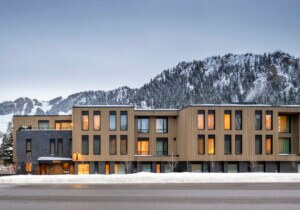Last spring, Forbes announced that a Colorado real estate developer had broken ground on Populus, “the first carbon-positive hotel in the U.S.”
The article—which echoed claims made by the project’s developer, Urban Villages, in a press release—stated that Populus, designed by Studio Gang for a site in downtown Denver, would help slow climate change by reducing the amount of carbon in the atmosphere. Some people might call that “carbon negative,” but the developer’s meaning was clear.
What’s not clear is that a carbon-positive hotel is even possible. It certainly, according to experts I consulted, isn’t possible with existing technology.
But Urban Villages has gotten a lot of mileage out of its claim. Googling “populus denver ‘carbon positive’” produces about 1,000 results. That’s a lot of free publicity. So far as I could tell, only one article, by Lloyd Alter of Treehugger, disputed the carbon-positive claim, noting, among other things, that it’s far too early to laud the performance of a building that won’t even open until 2024.
Publications love to report good news, especially when it comes to global warming, which may explain their failure to ask hard—or any—questions. The press glommed on to the carbon-positive myth.
But make no mistake: The claim is far from harmless. To slow down global warming, we will have to make significant changes to how we live. Calling a hotel or any urban building “carbon positive” is dangerous because it suggests those changes aren’t really necessary.
Sure, you can build a hotel and then plant a forest in a remote location and hope the trees absorb more carbon from the atmosphere than the hotel emits. (That’s what the developer of Populus plans to do.) But that tells you nothing about the sustainability of the hotel, since, with enough trees, you could offset anything. If you count remote offsets, even the most wasteful building could qualify as carbon positive (with a big asterisk).
And even if the trees did sequester enough carbon, you haven’t built a zero-carbon building. You’ve built a net zero-carbon building, which is another thing entirely. Net zero is an accounting trick, not an environmental strategy.
To be fair, Populus will have more green features than most new buildings. Working with Jeanne Gang, the building’s high-profile architect, and a number of consultants, Urban Villages has made a genuine effort to minimize the building’s energy consumption. It looked not only at operational energy, which will power the building after it opens, but also at embodied energy: the energy needed to build the hotel in the first place. On the operational energy front, Gang and her team developed a building envelope that minimizes heating and cooling loads. To cut embodied energy, they asked the contractor to use low-carbon concrete. That’s important because the production of cement (a part of almost all concrete) is itself responsible for up to 8 percent of the world’s greenhouse gas emissions. According to Jon Buerge, chief development officer and partner at Urban Villages, Populus is being built with ECOPact Low-Carbon Concrete, a Holcim product that uses fly ash instead of cement, reducing the concrete’s carbon content by about 30 percent.
The developer has taken a variety of other energy-saving steps. It pushed its contractor to use recycled materials whenever possible, and to source them locally. And there will be no on-site parking. That encourages people to use public transportation, although it’s not clear how many out-of-town visitors to the downtown Denver hotel would have come by private car.
So, the building may use less energy than the typical hotel. Maybe 10 or 20 percent less. Maybe even 30 percent less? That isn’t nothing. But it is hardly carbon positive.
So why does the developer feel entitled to make that audacious claim? Trees. Tens of thousands of trees. When the design of Populus was nearly complete, Urban Villages estimated its operational energy needs and hired Stok to do the same for its embodied energy. It’s important to know that operational energy use almost always turns out to be higher than predicted. And estimates of embodied energy are often far too low. That’s because the embodied energy of some building components is so hard to measure that consultants just ignore them. (In the case of Populus, the embodied energy of furniture and finishes is still being analyzed.)
Once the company had an estimate of total carbon emissions, it set out to see how it could offset that amount. Last year, it announced a plan to plant trees “that represent over 5,000 acres of forest” somewhere in the American West, according to press materials.
But relying on sequestration to zero out a building’s carbon footprint is highly problematic. You have to start with a reasonable estimate of how much carbon a given tree can sequester in its lifetime. (Some widely circulated numbers are too high.) You have to be sure that the tree wouldn’t have been planted anyway, and you have to be sure that it lives a long, healthy life. (If a tree burns, or decomposes, as billions of trees do every year, the carbon it stored winds up in the atmosphere—exactly where you don’t want it to be.) You have to think about what was on the site before. (Was the land barren, or was it already covered in carbon-sequestering grass or shrubs?) And you have to think about the energy that goes into planting and maintaining something like 5,000 acres of trees.
Urban Villages initially said it would monitor the new forest for ten years, but it would really need to monitor the forest for 100 years. If that seems impractical it’s just another reason why these kinds of offsets are unlikely to be effective. And, as several recent articles have pointed out, climate change itself is affecting the ability of trees to absorb carbon.
Recently Urban Villages adjusted its strategy. It now says it is going to work with the U.S. Forest Service, which will plant over 70,000 trees in Gunnison County, Colorado, and perform the monitoring. It’s wise to keep things local. Urban Villages also shared that the tree species will be selected to reduce beetle kill in the region.
Buerge noted in a phone call that “Colorado has an arid climate; the trees don’t sequester as much carbon as trees do in the Amazon. But we’d like to see the forest that we’re planting.” The developer is also looking for a partner to work with it on soil sequestration, the process of turning tilled agricultural land into pasture. In that scenario, animal waste replenishes depleted soil, which allows organic matter to multiply below ground, sequestering carbon as it increases in volume. (The documentary Kiss The Ground explains the process.) It’s an interesting idea, but let’s not declare its success before it has even been tried.
There are lots of other things that the developer needs to consider. For example: When Populus opens, how many plane trips and taxi rides will be taken that wouldn’t have been taken otherwise? That is part of the hotel’s emissions profile.
Asked about Urban Villages’s use of the phrase “carbon positive,” architect Gang wrote in an email: “It refers to their overall development strategy, inclusive of offsite efforts such as planting some 5,000 acres of forest. The building itself will not be carbon-positive.” As Gang surely knows, planting trees is a kind of architectural “get out of jail free” card. Kudos to the architect for her candor.
I believe Urban Villages also means well. Buerge admitted that not one molecule of CO2 has been offset yet and that the company still has a lot to learn. “It’s more complicated than we realized,” he said repeatedly during a phone interview. So why doesn’t the developer revoke its premature claim and apologize to all the architects whose clients have asked them, “Why can’t I have a climate-positive building too?”
Buerge isn’t likely to relinquish the role of enlightened developer and the publicity that comes with it. “We want to talk openly about this effort,” he wrote in an email, “because we want the industry to understand how we are doing this and how they could as well.” The desire to talk openly is a good thing. But it must include being open to hard truths.
Fred A. Bernstein is the winner of the 2023 award given by the American Academy of Arts and Letters to an American who explores ideas in architecture through any medium.
A prior version of this article was updated to clarify that Urban Villages intends to plant about 70,000 trees in its effort to offset Populus’s carbon emissions.











